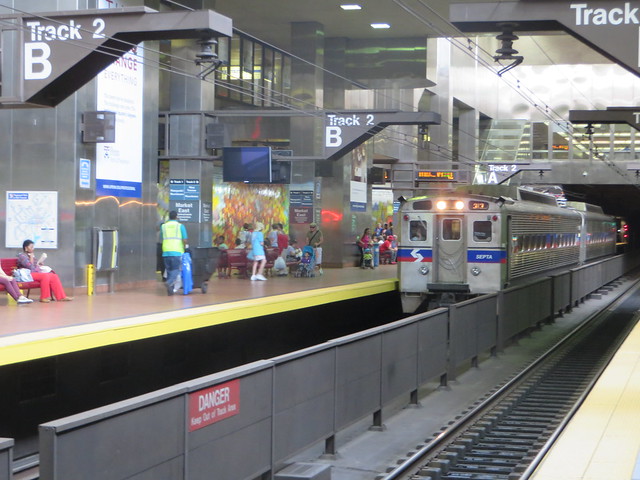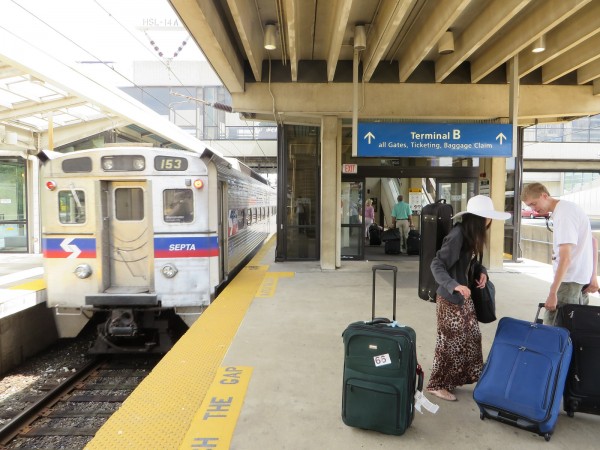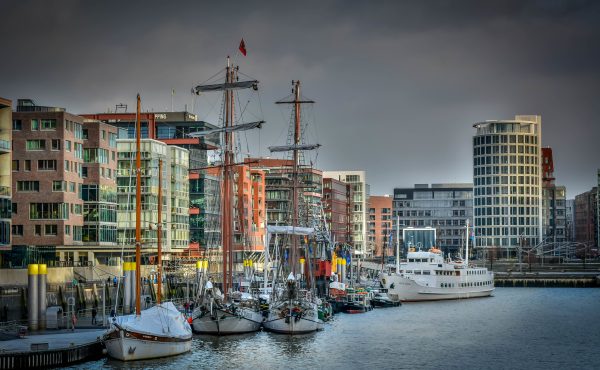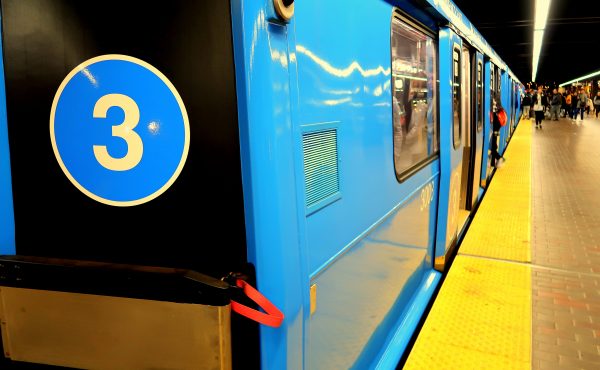EDITOR’S NOTE: This post is intended as a follow up to Glyn Bowerman’s commentary from yesterday on the high fares planned for the Union-Pearson Express.
Two weeks ago, I visited Philadelphia, the last stop on a three-city trip that also included Charleston and Savannah. After two-and-a-half days of sightseeing (mostly by foot or by bike, though I indulged in a ride on Philadelphia’s refurbished PCC streetcars), I walked with by bags from my Center City (Philly-speak for downtown) hotel to Market East rail station and bought a $6.50 ticket to ride on one of America’s best downtown-to-airport rail links. After boarding the train, I was at the TSA security check in just over 30 minutes.
Philadelphia’s Airport Line, operated by the Southeastern Pennsylvania Transportation Authority (SEPTA), is one of operating 20 airport rail links in the United States, but the only one utilizing regular regional/commuter rail trains connected to the airport terminals. This is also the model of service that Denver, Colorado is planning for its East Rail Line, an electric regional rail line due to open in 2016. (Providence, Rhode Island, Burbank, California, and South Bend, Indiana have commuter/regional rail links to their airports, but services there are much less frequent than SEPTA’s.)
I wrote about SEPTA after my first visit to Philadelphia five years ago. Philly’s transit agency operates buses, trolley buses, streetcars, suburban light rail, subways, and regional rail throughout Philadelphia and its suburbs. It even has a transit gift shop. All that said, SEPTA is underfunded, and neglects much of its older infrastructure, including several streetcar lines left idle for decades. It hasn’t built any major new transit infrastructure since 1985. But there are still a few things Toronto can learn from the City of Brotherly Love.
Like all of SEPTA’s regional rail lines, the Airport Line uses electric multiple unit trainsets. Trains operate every 30 minutes, 7 days a week, from early mornings until about midnight. Airport Line trains originate at Temple University, in Philadelphia’s near north end and serve three central stations — Market East, Suburban Station and 30th Street Station — via the Center City Commuter Connection, a four-track rail tunnel completed in 1984. 30th Street Station is the main Amtrak station serving Philadelphia. From 30th Street, the line continues south, stopping at University City (serving University of Pennsylvania, Drexel University and a large medical campus) and at Eastwick, a neighbourhood near the airport. All stations on the Airport Line (unlike most regional rail stations) feature high platforms, a useful feature when lugging bags or pushing strollers. There are four stops at the airport, making it a very short walk from the train platform, up the escalator or elevator to the right check-in counters and security inspection stations. From Suburban Station (which despite its name, serves Philly’s financial district), it takes 19 to 24 minutes to arrive at the airport, on a 16-kilometre (10 mile) long route. In comparison, the Union Pearson rail link will be 23 kilometres (14.5 miles) in length.
Philadelphia’s rail link is also affordable for airport workers, a market the Union Pearson Express ignores. Weekly and monthly SEPTA passes (an adult weekly pass is $24; a monthly pass is $91) are permitted for travel on the Airport Line (unlike other SEPTA regional rail lines, which require additional fares or more expensive passes) between Center City and the Airport.

SEPTA regional rail trail in Market East Station
So why didn’t Toronto choose to go with the Philadelphia model for building an airport rail link?
With the exception of transit across the Delaware River to Camden, New Jersey and its suburbs, SEPTA is the sole provider of transit services in the Philadelphia metropolitan area, including regional rail services. Fare integration between different nodes was easier to implement. SEPTA already owned and operated an extensive electrified rail system, the legacy of the old Pennsylvania and Reading Railroad networks, while GO Transit/Metrolinx had to build a commuter rail system from scratch starting in 1967, using longer, diesel-powered trainsets. Unlike SEPTA, GO offers off-peak regional rail services only on two corridors (Lakeshore East and West). In Toronto, transit is provided by the local municipalities and by GO Transit, and there is little, if any, coordination between them. There is a lack fare integration between GO Transit, the TTC, and suburban transit agencies.
But the biggest problem is that the Union-Pearson Express, first conceived by Federal Minister of Transportation David Collenette in 2001 as “Blue 22”, was always planned as a public-private partnership that was geared towards business travellers, not the general public. Metrolinx, the provincial agency now responsible for the Union-Pearson Express, has chosen to implement the Blue 22 model, even though its own mandate is “to improve the coordination and integration of all modes of transportation in the Greater Toronto and Hamilton Area.” The Union-Pearson Express’ premium service model seems be counter to that basic mandate. Denver is building a new electric airport rail link from scratch (as part of a very ambitious FasTracks program), but has chosen to operate it as part of its transit system, like Philadelphia. It’s too bad Toronto isn’t doing the same.
Photos: Sean Marshall





7 comments
In the three months to end March 2014, Pearson airport paid $33m in rent to the Federal government, exclusive of any other income or sales taxes that business generates. The feds (as opposed to the GTAA) have not contributed to the construction of the airport link, but as airport rents are linked to airport income, they will benefit from any uplift the spending of provincial taxpayers on UPX provides to Pearson directly and via the parking tax on UPX tickets.
Denver’s “Eagle P3” combining the north and east (airport) rail lines has received US$1bn in federal support.
We could have nicer things if the feds would, while taking airport traveller cash, return some of it in better transportation links to said airport.
The Big Move called for access to Pearson from all directions, and if the “grand vision” is realized we’ll get:
1) Airport Express Train
2) Finch West LRT to the airport, connecting with regular fare GO trains near Woodbine Racetrack.
3) Eglinton Crosstown to the airport.
4) GO buses and BRT on bus-only roads to the airport from places like Mississauga, Brampton and Vaughan.
Personally, I’m going to focus my advocacy time on 2-4 because of the far greater benefits region-wide and I think everyone should too. When we change one of the elements the network begins to crumble.
Growing up in Vancouver & Burnaby, BC Hydro trolley buses were my “Beige Buckets” so my 1st ever subway ride, at 21, was on the 1st ever subway: The London Underground.
WIth Trapper Nelson canvas & wood backpack on my back, looking suitably like a Colonial from British Columbia, I fearlessly took “The Tube” from Heathrow Airport to the Carter Lane Youth Hostel near Fleet Street & St. Paul’s Cathedral.
As I read the UPExpress fare controversy, I went to Heathrow’s website, and marvelled at their many options (for ALL VISITORS, not just Canary Wharf), just as Sean found operated in Philly by SEPTA!
Check out Heathrow’s Transport-for-London here: http://www.heathrowairport.com/transport-and-directions/underground and the plethora of other public transportation options for travelling to & from London here: http://www.heathrowairport.com/transport-and-directions/getting-into-london
Eat your heart out, Toronto! $30 or bust!
I would rather have seen a frequent people-mover run up to the Malton GO station with improvements made to turn it into a regional hub for GO, VIA, Mississauga, Brampton, YRT and TTC similar to the JFK AirTrain to Jamaica. You could put in the express service between Malton and Union with the Union-Pearson Express, direct express with VIA, plus have local service run by GO. The near-range local service would be provided by the local transit agencies. You would then have a broad range of fares and speeds to choose from.
Granted, it wouldn’t be a single-seat ride, but it would give access to a large part of southern Ontario were it set up this way. It would also give the International Centre a reason to freshen up its appearance since there’ll be all this extra traffic at its front door!
Gil – there was talk at one time of a station similar to what you describe at Woodbine connecting to an extension of the current peoplemover (likely replacing the existing cable technology with a self-propelled system), which would have also allowed Finch West to run into it after passing Humber College and the racecourse.
The thing that irritates me about what passes for discussion of this project in the papers and social media is this:
1. The original Transport Canada RFP was 13 years ago. Since that time, the project which started as Blue 22 (22 minutes for $22) has changed little in scope (the addition of the Bloor and Weston stops and using new rather than refurb equipment). If someone is surprised that this train won’t cost TTC or even GO fare ($6.80 one way to Malton) as Josh Matlow appears to be, they are new to the subject matter, as a City Councillor should not be.
2. The hope among those who were paying attention was that the Feds and SNC Lavalin would lose interest and that the Province would take over the project – which happened in 2009. Unfortunately, instead of sitting down with GTAA, Toronto and Peel and saying “let’s look at the basic assumptions being made, including the short terminal at Pearson limiting capacity of airport trains”, they assumed the project with minor changes because the Pan Am boosters needed a bauble for their bid document. The McGuinty cabinet needs to bear responsibility here.
3. This project, connecting as it does the business district and the airport, was always going to be open to some sort of class issue. Those who want the Island Airport want as many business people on it as possible so as to starve Porter. This is now decried as “an executive train”. But as long as it is an executive train, it can be demanded that the operating costs of it don’t burden the rest of the system by appropriate fares. Now there are demands to have airport workers get to the airport at a discount. Metrolinx have recently said they will operate demand pricing, as they should. Seats should be filled to justify the massive capital expense. But if fares are discounted at times when the trains are full then this limits the income of the train operation, and leaves the train open to being overbooked, decreasing the appeal for time sensitive travellers.
Assuming that GTAA makes no effort to contribute to this service for their workers (and I do) then if this flips to an operating loss (and to this point we’re assuming the Province is eating the interest on the $450m capital spend) is Josh Matlow going to bring a proposal to council, and spend the political capital, to have the City of Toronto contribute to the difference? If not, then other municipalities in the 905 and 519 provincial battleground seats who are obliged to contribute significant sums of their budgets to GO contributions will ask what is going on.
Instead of being prescriptive in a vacuum about the sort of service UPX will provide, let’s start with a simpler demand – that Metrolinx release its hitherto withheld business case. Let’s have an open discussion of the assumptions being made and a commitment to early and frequent reporting of ridership and financials, and any notion of commercial confidentiality (especially from GTAA) be damned.
Yes, that will mean the coach companies and taxi operators may raise hell if, as is suspected, the spreadsheets don’t match the optimism of the public relations and the service is expected to need subsidy. But at least this public project can be properly assessed, debated and, if necessary and to the extent possible, improved.
Mark – Yes, I’m familiar with the Woodbine station plan which was tied to some form of redevelopment of the Woodbine lands and is still awaiting shovels in the ground as the rail line nears completion. Malton would simply need upgrades rather than starting from scratch. It’s location doesn’t preclude an extension of the Finch West LRT south on Hwy. 27 and then west on Rexdale and Derry.
The article has it right, We need a less than $10 fare from Union Station to Pearson airport. We also need far more competitive airport fees at Pearson to compete with Buffalo… but that’s another topic.